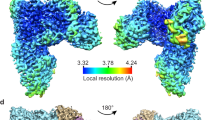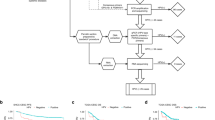Abstract
Through a glucocorticoid-responsive promoter, glucocorticoids can regulate the transcription of the human papillomavirus (HPV) E6 and E7 viral genes which target the tumour suppressor proteins p53 and Rb respectively. In C4-1 cells, the glucocorticoid dexamethasone up-regulated HPV E6/E7 mRNA and decreased radiation-induced apoptosis. In contrast, dexamethasone had no effect on apoptosis of cells that either lack the HPV genome (C33-a) or in which HPV E6/E7 transcription is repressed by dexamethasone (SW756). Irradiated C4-1 cells showed increased p53 expression, while dexamethasone treatment prior to irradiation decreased p53 protein expression. In addition, p21 mRNA was regulated by irradiation and dexamethasone in accordance with the observed changes in p53. Overall, glucocorticoids decreased radiation-induced apoptosis in cervical carcinoma cells which exhibit increased HPV E6/E7 transcription and decreased p53 expression. Therefore, in HPV-infected cervical epithelial cells, p53-dependent apoptosis appears to depend upon the levels of HPV E6/E7 mRNA. © 2000 Cancer Research Campaign
Similar content being viewed by others
Article PDF
Change history
16 November 2011
This paper was modified 12 months after initial publication to switch to Creative Commons licence terms, as noted at publication
References
Almasan A, Linke SP, Paulson TG, Huang L and Wahl GM (1995) Genetic instability as a consequence of inappropriate entry into and progression through S phase. Cancer Metast Rev 14: 59–73
Band V, DeCaprio JA, Delmolino L, Kulesa V and Sager R (1991) Loss of p53 protein in human papillomavirus type 16 E6-immortalized human mammary epithelial cells. J Virol 65: 6671–6676
Bracey TS, Miller JC, Preece A and Paraskeva C (1995) Gamma-radiation-induced apoptosis in human colorectal adenoma and carcinoma cell lines can occur in the absence of wild type p53. Oncogene 10: 2391–2396
Butz K, Shahabeddin L, Geisen C, Spitovsky P, Ullmann A and Hoppe-Seyler F (1995) Functional p53 protein in human papillomavirus-positive cancer cells. Oncogene 10: 927–936
Butz K, Geisen C, Ullmann A, Spitovsky D and Hoppe-Seyler F (1996) Cellular responses of HPV-positive cancer cells to genotoxic anti-cancer agents, repression of E6/E7-oncogene expression and induction of apoptosis. Int J Cancer 68: 506–513
Butz K, Whitaker N, Denk C, Ullmann A, Geisen C and Hoppe-Seyler F (1999) Induction of the p53-target gene GADD45 in HPV-positive cancer cells. Oncogene 18: 2381–2386
Clark AR, Purdie CA, Harrison DJ, Morris RG, Bird CC, Hooper ML and Wyllie AH (1993) Thymocyte dependent apoptosis induced by p53-dependent and independent pathways. Nature 362: 849–852
Crook T, Tidy JA and Vousden KH (1991) Degradation of p53 can be targeted by HPV E6 sequences distinct from those required for p53 binding and trans-activation. Cell 67: 547–556
Demers GW, Foster SA, Halbert CL and Galloway DA (1994) Elevated wild-type p53 protein levels in human epithelial cell lines immortalized by the human papillomavirus type 16 E7 gene. Proc Natl Acad Sci USA 91: 4382–4386
Dyson N, Howley PM, Munger K and Harlow E (1989) The human papilloma virus-16 E7 oncoprotein is able to bind to the retinoblastoma gene product. Science 243: 934–936
el-Deiry WS, Tokino T, Velculescu VE, Levy DB, Parsons R, Trent JM, Lin D, Mercer WE, Kinzler KW and Vogelstein B (1993) WAF1, a potential mediator of p53 tumor suppression. Cell 75: 817–825
Gloss B, Bernard HU, Seedorf K and Klock G (1991) The upstream regulatory region of the human papillomavirus contains an E2 protein independent enhancer which is specific for cervical carcinoma and regulated by glucocorticoid hormones. EMBO 6: 3735–3743
Harper JW, Adami GR, Wei N, Keyomarsi K and Elledge SJ (1993) The p21 Cdk-interacting protein Cip1 is a potent inhibitor of G1 cyclin-dependent kinases. Cell 75: 805–816
Hickman ES, Bates S and Vousden KH (1997) Perturbation of the p53 response by human papillomavirus type 16 E7. J Virol 71: 3710–3718
Hoppe-Seyler F and Butz K (1994) Cellular control of human papillomavirus oncogene transcription. Mol Carcinogenesis 10: 134–141
Iglesias M, Yen K, Gaiotti D, Hildesheim A, Stoler MH and Woodworth CD (1998) Human papillomavirus type 16 E7 protein sensitizes cervical keratinocytes to apoptosis and release of interleukin-1alpha. Oncogene 17: 1195–1205
Kangas A, Nicholson DW and Hottla E (1998) Involvement of CPP32/Caspase-3 in c-Myc-induced apoptosis. Oncogene 16: 387–398
Kessis TD, Slebos RJ, Nelson WG, Kastan MB, Plunkett SM, Han AT, Lorincz L, Hedrick L and Cho KL (1993) Human papillomavirus 16 E6 expression disrupts the p53-mediated cellular response to DNA damage. Proc Natl Acad Sci USA 90: 3988–3992
Lazo PA (1999) The molecular genetics of cervical carcinoma. Br J Cancer 80: 2008–2018
Lechner MS and Laimins LA (1994) Inhibition of p53 DNA binding by human papillomavirus E6 proteins. J Virol 68: 4262–4273
Lowe SW and Ruley HE (1993) Stabilization of the p53 tumor suppressor is induced by adenovirus E1A and accompanies apoptosis. Genes Dev 7: 535–545
Lowe SW, Schmitt EA, Smith SW, Osbourne BA and Jacks T (1993) p53 is required for radiation-induced apoptosis in mouse thymocytes. Nature 362: 847–849
Mittal R, Tsutsumi K, Pater A and Pater MM (1993) Human papilloma virus type 16 expression in cervical keratinocytes: role of progesterone and glucocorticoid hormones. Obs Gyn 81: 5–12
Morgenbesser SD, Williams BO, Jacks T and DePinho RA (1994). Nature 371: 72–74
Naumann U, Durka S and Weller M (1998) Dexamethasone-mediated protection from drug cytotoxicity, association with p21 WAF1/CIP1 protein accumulation?. Oncogene 7: 1567–1575
Pan H and Griep AE (1994) Altered cell cycle regulation in the lens of HPV-16 E6 or E7 transgenic mice: implications for tumour suppressor gene function in development. Genes Dev 7: 1285–1299
Pan H and Griep AE (1995) Temporally distinct patterns of p53-dependent and independent apoptosis during mouse lens development. Genes Dev 9: 2157–2169
Puthenveettil JA, Frederickson SM and Reznikoff CA (1996) Apoptosis in human papillomavirus 16 E7-, but not E6-immortalised human uro-epithelial cells. Oncogene 13: 1123–1131
Radford IR (1994) p53 status, DNA double-strand break repair proficiency, and radiation response of mouse lymphoid and myeloid cell lines. Int J Radiat Biol 66: 557–560
Scheffner M, Werness BA, Huibregtse JM, Levine AJ and Howley PM (1990) The E6 oncoprotein encoded by HPV types 16 and 18 promotes the degradation of p53. Cell 63: 1129–1136
Scheffner M, Munger K, Byrne JC and Howley PM (1991) The state of the p53 and retinoblastoma genes in human cervical carcinoma cell lines. Proc Natl Acad Sci USA 88: 5523–5527
Shaw P, Bovey R, Tardy S, Sahli R, Sordat B and Costa J (1992) Induction of apoptosis by wildtype p53 in a human colon tumor-derived cell line. Proc Natl Acad Sci USA 89: 4495–4499
Stern E, Forsythe AB, Youkeles L and Coffelt CF (1977) Steroid contraceptive use and cervical dysplasia: increased risk of progression. Science 196: 1460–1462
Stoppler H, Stoppler MC, Johnson E, Simbulan-Rosenthal CM, Smulson ME, Iyer S, Rosenthal DS and Schlegel R (1998) The E7 protein of human papillomavirus type 16 sensitizes primary human keratinocytes to apoptosis. Oncogene 17: 1207–1214
Strasser A, Harris AW, Jacks T and Cory S (1994) DNA damage can induce apoptosis in proliferating lymphoid cells via p53-independent mechanisms inhibitable by Bcl-2. Cell 79: 329–339
Thomas M, Nassimi P, Jenkins J and Banks L (1995) HPV-18 E6 mediated inhibition of p53 DNA binding activity is independent of E6 induced degradation. Oncogene 10: 261–268
Thomas M, Matlashewski G, Pim D and Banks L (1996) Induction of apoptosis by p53 is independent of its oligomeric state and can be abolished by HPV-18 E6 through ubiquitin mediated degradation. Oncogene 10: 109–115
Von Knebel Doeberitz M, Tilman O, Schwarz E and Gissmann L (1988) Correlation of modified human papilloma virus early gene expression with altered growth properties in C4-1 cervical carcinoma cell lines. Cancer Res 48: 3780–3786
Von Knebel Doeberitz M, Koch S, Drzonek H and ZurHausen H (1990) Glucocorticoid hormones reduce the expression of major histocompatibility class I antigens on human epithelial cells. Eur J Immunol 20: 35–40
Von Knebel Doeberitz M, Bauknecht T, Bartsch D and ZurHausen H (1991) Influence of chromosomal integration on glucocorticoid-regulated transcription of growth-stimulating papillomavirus genes E6/E7 in cervical carcinoma cells. Proc Natl Acad Sci USA 88: 1411–1415
Von Knebel Doeberitz M, Ritmuller C, Zur Hausen H and Durst M (1992) Inhibition of tumorigenicity of cervical cells in nude mice by HPV E6/E7 anti-sense RNA. Int J Cancer 55: 831–834
Von Knebel Doeberitz M, Ritmuller C, Aengeneyndt F, Jansen-Durr P and Spitovsky D (1994) Reversible repression of papillomavirus oncogene expression in cervical carcinoma cells: consequences for the phenotype and E6-p53 and E7-pRb interactions. J Virol 68: 2811–2821
Walboomers JM, Jacobs MV, Manos MM, Bosch FX, Kummer JA, Shah KV, Snijders PJ, Peto J, Meijer CJ and Munoz N (1999) Human papillomavirus is a necessary cause of invasive cervical cancer worldwide. J Pathol 189: 12–19
Wang Y, Okan I, Pokrovskaja K and Wiman KG (1996) Abrogation of p53-induced G1 arrest by the HPV16 E7 protein does not inhibit p53-induced apoptosis. Oncogene 12: 2731–2735
Werness BA, Levine AJ and Howley PM (1990) Association of HPV types 16 and 18 E6 proteins with p53. Science 248: 76–79
White E (1996) Life, death, and the pursuit of apoptosis. Genes and Dev 10: 1–15
Yonish-Rouach E, Resnitzky D, Lotem J, Sachs L, Kimchi A and Oren M (1991) Wildtype p53 induces apoptosis of myeloid leukaemic cells that is inhibited by interleukin-6. Nature 352: 345–347
Yu Y and Little JB (1998) p53 is involved in but not required for ionizing radiation-induced caspase-3 activation and apoptosis in human lymphoblast cell lines. Cancer Res 58: 4277–4281
Zur Hausen H (1991) Human papillomaviruses in the pathogenesis of anogenital cancer. Virology 184: 9–13
Author information
Authors and Affiliations
Rights and permissions
From twelve months after its original publication, this work is licensed under the Creative Commons Attribution-NonCommercial-Share Alike 3.0 Unported License. To view a copy of this license, visit http://creativecommons.org/licenses/by-nc-sa/3.0/
About this article
Cite this article
Kamradt, M., Mohideen, N., Krueger, E. et al. Inhibition of radiation-induced apoptosis by dexamethasone in cervical carcinoma cell lines depends upon increased HPV E6/E7. Br J Cancer 82, 1709–1716 (2000). https://doi.org/10.1054/bjoc.2000.1114
Received:
Revised:
Accepted:
Published:
Issue date:
DOI: https://doi.org/10.1054/bjoc.2000.1114
Keywords
This article is cited by
-
Regulation of differential pro- and anti-apoptotic signaling by glucocorticoids
Apoptosis (2007)
-
High-risk human papilloma virus (HPV) and survival in patients with esophageal carcinoma: a pilot study
BMC Cancer (2006)
-
Antiviral agent Cidofovir restores p53 function and enhances the radiosensitivity in HPV-associated cancers
Oncogene (2002)



